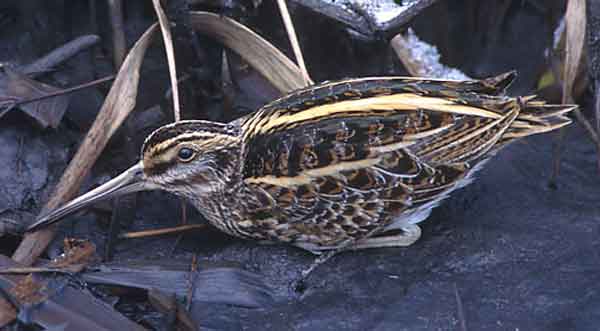
Lymnocryptes minimus (*)
Superregnum: Eukaryota
Regnum: Animalia
Subregnum: Eumetazoa
Cladus: Bilateria
Cladus: Nephrozoa
Superphylum: Deuterostomia
Phylum: Chordata
Subphylum: Vertebrata
Infraphylum: Gnathostomata
Superclassis: Tetrapoda
Cladus: Reptiliomorpha
Cladus: Amniota
Classis: Reptilia
Cladus: Eureptilia
Cladus: Romeriida
Subclassis: Diapsida
Cladus: Sauria
Infraclassis: Archosauromorpha
Cladus: Crurotarsi
Divisio: Archosauria
Subsectio: Ornithodira
Subtaxon: Dinosauromorpha
Cladus: Dinosauria
Ordo: Saurischia
Cladus: Eusaurischia
Cladus: Theropoda
Cladus: Neotheropoda
Cladus: Averostra
Cladus: Tetanurae
Cladus: Avetheropoda
Cladus: Coelurosauria
Cladus: Maniraptoromorpha
Cladus: Maniraptoriformes
Cladus: Maniraptora
Cladus: Pennaraptora
Cladus: Eumaniraptora
Cladus: Avialae
Infraclassis: Aves
Cladus: Euavialae
Cladus: Avebrevicauda
Cladus: Pygostylia
Cladus: Ornithothoraces
Cladus: Euornithes
Cladus: Ornithuromorpha
Cladus: Ornithurae
Cladus: Carinatae
Parvclassis: Neornithes
Cohors: Neognathae
Ordo: Charadriiformes
Subordo: Charadrii
Familia: Scolopacidae
Genus: Lymnocryptes
Species: Lymnocryptes minimus
Name
Lymnocryptes minimus (Brünnich, 1764)
Synonyms
Scolopax minima (protonym)
References
Ornithologia borealis: 49
Vernacular names
العربية: الشنقب الصغير
asturianu: Mexaperros
azərbaycanca: Qarşnep
башҡортса: Ваҡ һаралйын
беларуская (тарашкевіца): Стучок
беларуская: Гаршнэп
български: Малка бекасина
বাংলা: জ্যাক চ্যাগা
brezhoneg: Krakkioc'h
català: Becadell sord
čeština: Slučka malá
Cymraeg: Gïach bach
dansk: Enkeltbekkasin
Deutsch: Zwergschnepfe
ދިވެހިބަސް: Onna Ilolhi
Ελληνικά: Κουφομπεκάτσινο
English: Jack Snipe
Esperanto: Malgranda galinago
español: Agachadiza chica
eesti: Mudanepp
euskara: Istingor txiki
suomi: Jänkäkurppa
føroyskt: Lítil mýrisnípa
Nordfriisk: Hualewsnep
français: Bécassine sourde
Frysk: Haarsnip
Gaeilge: Naoscach Bhídeach
Gàidhlig: Gobhrag bheag
galego: Becacina pequena
Gaelg: Coar veg
עברית: חרטומית גמדית
hrvatski: Mala šljuka
magyar: Kis sárszalonka
հայերեն: Վարսակտցար
íslenska: Dvergsnípa
italiano: Frullino
日本語: コシギ
ქართული: ჭყინპო
қазақша: Шаушалшық
한국어: 꼬마도요
kurdî: Çikçikeyê nikilkurt ê biçûk
kernowek: Dama kyogh
Lëtzebuergesch: Daf Bekassinn
Limburgs: Kleine Watersnep
lietuvių: Oželis nykštukas
latviešu: Vistilbe
македонски: Мала бекасина
മലയാളം: ചെറിയ ചുണ്ടന് കാട
монгол: Бичил салалж - ᠪᠢᠴᠢᠯ ᠰᠠᠯᠠᠯᠵᠢ
Malti: Ċinkonja
Nedersaksies: Vennesik
Nederlands: Bokje
norsk nynorsk: Kvartbekkasin
norsk: Kvartbekkasin
Nouormand: P'tite bécachinne
polski: Bekasik
پنجابی: جیک سنائپ
português: Narceja-galega
rumantsch: Becassina pitschna
română: Becațină mică
русский: Гаршнеп
саха тыла: Гаршнептар уустара
sicilianu: Facinedda
davvisámegiella: Jeaggemeahkástat
slovenčina: Močiarnica tichá
slovenščina: Puklež
shqip: Shapka e vogël e ujit
српски / srpski: Mala šljuka - Мала шлјука
svenska: Dvärgbeckasin
Kiswahili: Sululu mdogo
தமிழ்: Korai Ullan
ไทย: นกปากซ่อมเล็ก
Türkçe: Küçük su çulluğu
українська: Баранець малий
Tiếng Việt: Dẽ giun nhỏ
West-Vlams: Doverikje
Zeêuws: Lappertje
中文: 姬鹬
The jack snipe or jacksnipe (Lymnocryptes minimus) is a small stocky wader. It is the smallest snipe, and the only member of the genus Lymnocryptes. Features such as its sternum make it quite distinct from other snipes or woodcocks.[2][3]
Etymology
The common name has been said to come from the Welsh word for a snipe, giach (pronounced with a hard g),[4] but modern dictionaries say it comes from the masculine name Jack.[5][6] Alfred Newton hypothesized that, "It may be, as in Jackass, an indication of sex, for it is a popular belief that the Jack-Snipe is the male of the common species; or, again, it may refer to the comparatively small size of the bird, as the 'jack' in the game of bowls is the smallest of the balls used, and as fishermen call the smaller Pikes Jacks."[2]
The genus name Lymnocryptes is from Ancient Greek limne, "marsh" and kruptos, "hidden". The species name minimus is from Latin and means "smallest".[7]
Description
Adults are smaller than common snipe and have relatively shorter bill. Length is 18–25 cm (7.1–9.8 in), wingspan is 30–41 cm (12–16 in) and weight is 33–73 g (1.2–2.6 oz).[8] The body is mottled brown on top and pale underneath. They have a dark stripe through the eye. The wings are pointed and narrow, and yellow back stripes are visible in flight. When seen, the distinctive bobbing movement, as if the bird is on springs, has an almost hypnotic quality.
The head pattern of jack snipe differs from common snipe and other species in the genus Gallinago, in that there is no central crown-stripe; instead, there are two pale lateral crown-stripes, which are separated from the supercilium by an area of dark plumage.
Distribution and habitat
Jack snipes are migratory, spending the non-breeding period in Great Britain, Atlantic and Mediterranean coastal Europe, Africa, and India. The jack snipe is one of the species to which the Agreement on the Conservation of African-Eurasian Migratory Waterbirds (AEWA) applies. Their breeding habitat is marshes, bogs, tundra and wet meadows with short vegetation in northern Europe and northern Russia.
Behaviour
Jack snipe egg
Jack snipe can be secretive in their non-breeding areas and are difficult to observe, being well camouflaged in their habitat. Consequently, birdwatchers have developed a specialised technique for finding them. This involves walking through its marshy habitat until a bird is disturbed and flies up. Jack snipe will squat down and not flush from cover until an intruder is quite close.[2] They then quietly fly a short distance before dropping back into vegetation.[2]
Feeding
They forage in soft mud, probing or picking up food by sight. They mainly eat insects and earthworms, also plant material.
Breeding
The male performs an aerial display during courtship, during which it makes a distinctive sound like a galloping horse. It is silent in winter. They nest in a well-hidden location on the ground, laying 3–4 eggs.
References
BirdLife International (2016). "Lymnocryptes minimus". IUCN Red List of Threatened Species. 2016: e.T22693133A86640472. doi:10.2305/IUCN.UK.2016-3.RLTS.T22693133A86640472.en. Retrieved 11 November 2021.
Newton, Alfred (1911). "Snipe" . In Chisholm, Hugh (ed.). Encyclopædia Britannica (11th ed.). Cambridge University Press.
Thomas, Gavin H.; Wills, Matthew A.; Székely, Tamás (2004). "A supertree approach to shorebird phylogeny". BMC Evolutionary Biology. 4 (28): 28. doi:10.1186/1471-2148-4-28. PMC 515296. PMID 15329156.
The Century Dictionary and Cyclopedia. Vol. IV. p. 3211.
"Jack Snipe". Dictionary.com Unabridged. (based on the Random House Unabridged Dictionary)
New Shorter Oxford English Dictionary. p. 1434.
Jobling, James A (2010). The Helm Dictionary of Scientific Bird Names. London: Christopher Helm. pp. 233, 256. ISBN 978-1-4081-2501-4.
Dunning, John B. Jr., ed. (1992). CRC Handbook of Avian Body Masses. CRC Press. ISBN 978-0-8493-4258-5.
Retrieved from "http://en.wikipedia.org/"
All text is available under the terms of the GNU Free Documentation License

